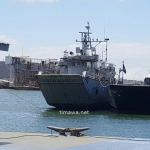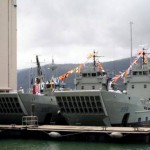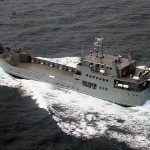
Philippine Defense Today (Adroth.ph)
In Defense of the Republic of the PhilippinesLanding Craft Utilities (LCU) of the Philippine Navy
Monday , 10, August 2015 LCU Mk.6, Philippine Navy Leave a commentLanding Craft Utilities (LCU) are ships designed to transport troops and material to shore without the need for piers and similar facilities. Smaller than ocean-going Landing Ship Tanks (LST), these vessels are currently used for inter-island transport of AFP maneuver units as well as for disaster relief operations. In conventional amphibious operations, both LSTs and LCUs would be used for administrative landings on established beachheads already captured from an enemy. They are not designed for landings under fire.
 |
| BRP Benguet, when it was still USN LST 692, with Mk.6 LCU #764 embarked. Photo by Joe Weber c/o navsource.org |
The Philippine Navy’s use of the term traces its origins to the landing craft it obtained from the US Navy. The USN originally called these vessels “Landing Craft Tank” during World War II, but reclassified them as LCUs in 1956.
The following table compares the four operational classes of LCUs in the Philippine Navy. Data for all vessels were either taken from Janes Fighting Ships 2014-2015 edition or Combat Fleets of the World 15th Edition. Because of a lack of direct information for the South Korean Mulkae class, the entries and photograph here were extrapolated from the LCU 1610 of the US Navy from which the South Korean boats were copied. Capacity information for the BRP Tagbanua, however, was obtained from members of the now defunct Philippine Navy Modernization Office, which oversaw the acquisition and sea trials of the vessel.
| ex-USN Mk.6 LCU | ex-ROKN Mulkae LCU | ex-RAN LCH | BRP Tagbanua | |||||
 |
 |
 |
 |
|||||
| Displacement, tonnes | 258 full load | 415 full load | 517 full load | 579 full load | ||||
| Dimensions, meters | 36.3 x 9.96 x 1.02 | 41.07 x 9.07 x 2.08 | 44.5 x 10.1 x 2 | 51.4 x 10 x 1.52 | ||||
| Speed, knots | 7 | 11 | 10 | 14 | ||||
| Range, miles | 700 @7kt | 560 @ 11kt | 3,000 @ 10kt | n/a | ||||
| Complement | 12 | 12 | 16 | n/a | ||||
| Military lift | 136 tons | 143 tons | 2 x M1A1 | 200 tons & 200 troops | ||||
| Inventory | BRP Tausug (AT-295) BRP Bagobo (AT-293) BRP Subanon (AT-291) |
Un-named LCU | BRP Ivatan (AT-298) BRP Batak (AT-299) |
BRP Tagbanua (AT-296) |
The bulk of these types of ships in Philippine Navy service consist of second-hand Excess Defense Articles (EDA), obtained from the United States and more recently from Australia and South Korea. Ships from the latter two countries arrived in 2015.
Two LCUs were built locally. One was commissioned into service with all the fan fare befitting a major Philippine manufacturing achievement. The other was quietly accepted under controversial circumstances. This second boat is best discussed in a separate future article, and will be omitted from this discussion.
The oldest ships in the fleet are ex-US Navy Mk.6 LCUs. Three of these World War II-era boats are currently in service: BRP Tausug (AT-295), BRP Bagobo (AT-293), BRP Subanon (AT-291). Though equally old as its sisterships, the BRP Tausug was a relatively new addition to the roster as it was recommissioned from the navy’s strategic reserves in 2009.
On the 30th of May, 2015, a Mulkae class LCU from South Korea, that had been donated to the Philippines in June 2014, arrived at the Cavite Naval Yard where it was slated to be refurbished. The Mulkae — which translates to “fur seal” — is the South Korean version of the US LCU 1610, of which six were built from 1979 to 1981. The Mulkae donated to the Philippines, designated LCU 78, entered South Korean service in 1981. As of writing the ship’s Philippine designation remains unclear.
On the 2nd of July 2015, Philippine Navy personnel arrived in Australia to take possession of two Balikpapan Class Landing Craft Heavy (LCH): HMAS Tarakan and HMAS Brunei. Both ships were commissioned into the Royal Australian Navy in 1973 and will be subject to navigational upgrades before being turned over to the Philippines. While the South Korean LCU’s designation remained unclear even after arrival in the Philippines, the names for the two Australian boats have already been announced, BRP Ivatan (AT-298) and BRP Batak (AT-299), while still overseas.
The first of the two new LCUs in the inventory is the BRP Tagbanua (AT-296). This ship is noteworthy, not only because it is not a hand-me-down, but also because it is a Philippine-built ship. It is currently the largest locally-built ship in the Philippine Navy, displacing the previous record holder: the Aguinaldo class patrol gunboats. AT-296 also remains the largest LCU in the fleet, surpassing the Balikpapaan class in both displacement and physical dimensions.
Another noteworthy differentiator for the Tagbanua was that it was designed specifically with the Philippine Navy’s intended use for these vessels in mind: inter-island movement of troops and equipment. For this reason, it can transport 200 troops within a passenger compartment, protected from the elements, in addition to carrying 200 tons or cargo.
Growing the force
In 2012, the Philippine Navy published what it called its Desired Force Mix. The mix laid out what the navy perceived as the minimum number of ships it required for various roles. The list identified a need for 18 Landing Craft Utilities. With only six LCUs either in service or due to enter service, there is a significant gap in amphibious capability. With that gap, however, comes opportunity for the Philippine shipbuilding industry.
When the tandem of Propmech and Philippine Iron Construction & Marine Works (PICMW) turned over the BRP Tagbanua to the Philippine Navy in November 2011, they not only proved that the local shipyards could meet military needs, they also demonstrated how widespread qualified shipyards in the country really are. This shipyard isn’t based in any of the usual suspects: Subic Bay, Balamban, Cebu or Batangas which often draw attention for their hosting foreign owned shipyards like Hanjin, Keppel, and Tsuneishi. PICMW calls Jasaan, Misamis Oriental home. This achievement shows that if the invitation to bid is made, industry players across the nation can respond with indigenous designs optimized for the AFP’s needs.
The acquisition project that eventually acquired the BRP Tagbanua had an Authorized Budget for Contract of approximately P190M. That translates to P2.85B worth of construction contracts that could potentially go to local shipyards if all 15 additional LCUs are sourced locally. Domestic manufacture, however, will always be hampered by one key consideration: “Time to deploy”.
Buying more EDA ships, like the Mulkae and Balikpapan class, would grow the LCU force faster. Especially when these assets are acquired in the form of a “hot transfer”, where the ship to be transferred is never actually decommissioned and simply changes crews. But this mode of acquisition not only deprives local shipyards of manufacturing opportunities, the resulting potpourri of ships also creates logistical issues by introducing a myriad of non-standard equipment. The existing six LCUs, for example, already involve four different engine types. Each of which will require a logistical trail.
Fifteen new locally-built LCUs following a single design would mean standardized equipment, and consequently simplify logistics. However, given how long it took the Tagbanua project to bear fruit, the DND-AFP would need to balance its need to fill the gap as-soon-as-possible, with other concerns to include its goal of supporting local manufacturing industries as part of the Self-Reliant Defense Posture (SRDP) program.
Arguably, the way forward for meeting the goals of the Desired Fleet Mix will require a combination of quick EDA acquisitions balanced with domestic production. The key will be in finding that balance, and designating a specific number that the domestic industry must be tasked — or challenged — to satisfy.
Discussion:
To discuss this article visit its companion thread on the Timawa.net forum here
Sources:
Janes Fighting Ships 2014 – 2015
US Amphibious Ships and Craft
Combat Fleets of the World, 15th Edition
http://www.naval-technology.com/projects/balikpapanclasslch/
http://www.naval-technology.com/news/newsphilippine-navy-to-receive-two-decommissioned-lch-vessels-from-australia-4532795
http://www.zambotimes.com/archives/news/91808-Australian-donated-LCHs-to-be-commissioned-on-July-23.html
http://ww2lct.org/mk6/mk6main.htm
http://www.navsource.org/archives/10/18/18idx.htm